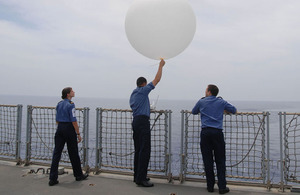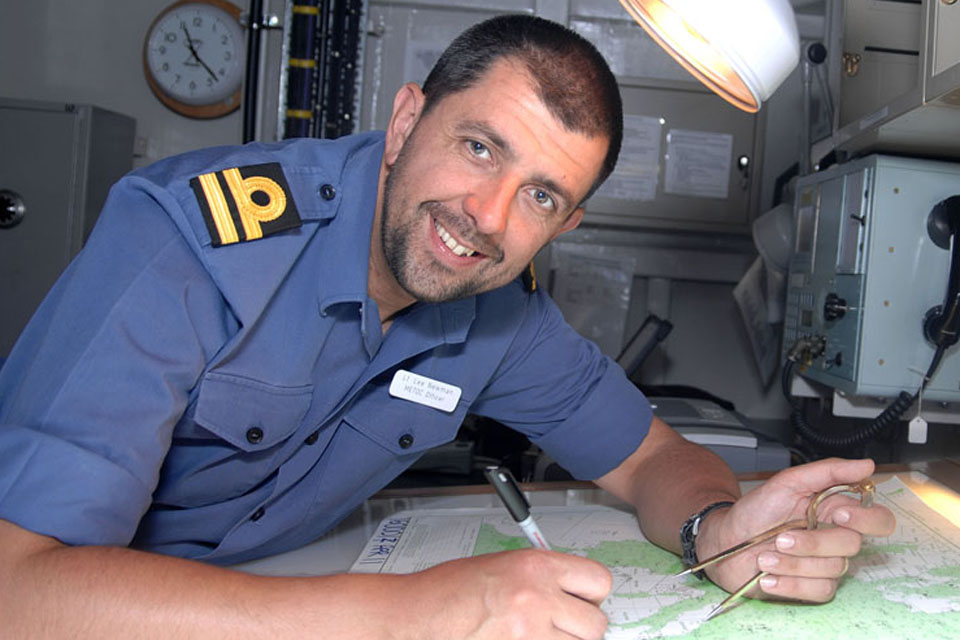The Royal Navy's weather gurus
In order to ensure that the Royal Navy's Response Force Task Group (RFTG) is prepared for any natural phenomenon which may affect their operations, a dedicated team is on hand to give them the low-down on the weather.

Able Seaman Kerry Woollard, Lieutenant Lee Newman and Leading Seaman Chris Edmonds release a weather balloon on board HMS Albion [Picture: Crown Copyright/MOD 2011]
Consisting of ships, aircraft and Royal Marines held at very high readiness, the RFTG is the UK’s maritime quick reaction force, poised to respond at short notice to unforeseen events in a fast-changing world.
And with the weather having such an impact on military operations, be they at sea, on the land or in the air, the RFTG has its very own meteorological team.
Lieutenant Lee Newman heads the Task Group’s meteorological team on board flagship HMS Albion. He said:
Weather will affect all aspects of the ship, including its personnel, aircraft, sensors and weapon systems. Careful consideration of weather conditions enables commanders to make best use of the Task Group in any operational situation.
It’s not just about the impact the weather has upon our equipment. It also shapes the challenges and missions we face. Perhaps the most obvious current example is the connection between the monsoon weather patterns and the instances of piracy in the Somali Basin and Horn of Africa.

Lieutenant Lee Newman heads the Response Force Task Group's meteorological team on board HMS Albion [Picture: Crown Copyright/MOD 2011]
Lieutenant Newman has the support of Leading Seaman Chris Edmonds and Able Seaman Kerry Woollard to collect, interpret and present the necessary data.
Lieutenant Newman explained:
We produce two tailored and specific weather forecasts each day for HMS Albion and the other ships in company, and also formally present a detailed forecast to the Task Group command team twice daily where not only bespoke weather information is delivered but also solar and lunar information.
Lieutenant Newman’s team has an array of gadgets and equipment at their disposal, including anemometers, barographs and thermometers.
Key data-gathering tools are the eye-catching giant weather balloons which the team release from HMS Albion’s flight deck on a daily basis. They travel into the atmosphere as high as 15 miles (24km) to record measurements of wind, air temperature, pressure and humidity.
This information not only informs the Task Group’s own weather forecasts, but is fed back to the UK Met Office in Exeter for use in their output.
For Able Seaman Woollard, this is her ideal job:
I have had an interest in meteorology from a young age,” she said, “but it was studying global hazards at Derby University which inspired me to pursue it as a career.
Whilst the team has one eye on the sky, their other eye is on the sea. Able Seaman Woollard said:
HMS Albion is my first sea draft, so it’s a steep learning curve. You have to take into account sea temperature and swell and surf, as this can affect operations.
Sightings of whales, dolphins and other marine mammals are recorded to assess and reduce the Navy’s impact on wildlife. This information is also shared with nature and conservation organisations, as are instances of bioluminescence in the ship’s wake (the ethereal green hue given off by algae at night).
However, it’s not all rainbows and dolphins - the meteorological team’s work has a fighting edge to it, as Leading Seaman Edmonds explained:
As well as contributing to the planning process, our data directly benefits the fighting capability of the Task Force.
One such aspect is the field of ballistic meteorology. In short, the Task Group’s frigate, HMS Sutherland, is able to use meteorological data to adjust her 4.5-inch [114mm] gun to take account of wind speed and other factors to ensure it hits the target.
At the end of May 2011 the Task Group was diverted from a multinational amphibious exercise to the Libyan coast. In an effort to increase pressure on Colonel Gaddafi, Apache helicopters from HMS Ocean were launched against selected military targets ashore, whilst HMS Albion acted as the floating command platform, directing and guiding the Task Group.
Leading Seaman Edmonds recalled:
The meteorological office is one of the few compartments on the ship that has a window. During the Apache missions we were close enough to see the individual lights along the Libyan coastline.
Helicopter operations, like those against regime targets in Libya, have to take into account factors which affect visibility, such as dust and moonlight. Environmental conditions are crucial to deciding if a mission goes ahead and ultimately determine whether it will be successful or not.
Lieutenant Newman takes enormous pride in his team’s work:
There is a genuine feeling of achievement when our predicted weather materialises, which, as we all know from TV weather reports, can be a difficult task.